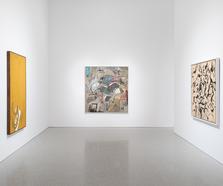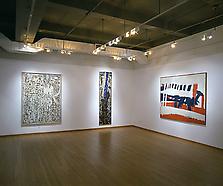“My painting starts with a complication on the canvas surface, done with as much spontaneity and as little memory as possible. This then exists as the subject. It is as strange as a new still life arrangement as confusing as any unfamiliar situation. It demands a long period of acquaintance during which it is observed both innocently and shrewdly. Then it speaks, quietly, with its own peculiar logic. Between painting and painter a dialogue develops, which leads rapidly to the bare confrontation of two personalities.” *
Born in St. Louis, Missouri in 1906, James Brooks spent his childhood in Colorado, Oklahoma, Illinois, and Texas, due to his father’s occupation as a traveling salesman. Brooks began drawing at a young age, finding his inspiration in comic strips and magazines. In the early 1920s, he studied at Southern Methodist University and the Dallas Art Institute. In 1926, Brooks left school to go to New York, where he studied at the Grand Central Art School with the illustrator Pruett Carter. Given his lack of exposure to art museums as a child, Brooks had never distinguished illustration from fine art before arriving in New York. When he began to see a difference, he lost interest in illustration, and left Grand Central to study with Kimon Nicolaides and Boardman Robinson at the Art Students League. To support himself, Brooks worked as a commercial artist, doing lettering. In the 1930s, with encouragement from Burgoyne Diller, Brooks joined the Federal Art Project of the WPA, where he met Jackson Pollock and Philip Guston. Like many WPA artists, Brooks was also a member of the Artists Union, which was organized to protect the rights of artists and workers. He created several murals for the WPA, including his famous Flight at the old rotunda of LaGuardia Airport’s Marine Air Terminal. Although the Port Authority painted over the mural in the 1950s, the work was restored roughly thirty years later. In 1942, Brooks joined the army. After the war, he returned to New York and began teaching art, first at Columbia University and then at the Pratt Institute.
In the late 1940s, Brooks turned away from his figural, Orozco-inspired social realism of the Depression and war years, and towards abstraction. Like Pollock and other abstract expressionists, Brooks was not content simply to find a new artistic voice; he wanted to dismantle approaches to painting that had become ingrained. An accidental discovery in 1947 inspired Brooks to develop a new method—after gluing a series of drawings onto Bemis cloth, Brooks noticed that the glue had seeped through the cloth, forming provocative shapes on the other side. He began staining his canvases and using the spontaneous splash of color as a foundation for a more deliberate painting. Building an abstract composition out of a quasi-accidental moment, Brooks conceptualized painting as “a chain of formal reactions.” In 1950, Brooks had his first solo show, at the Peridot Gallery in New York. The following year, he helped organize and participated in the famous Ninth Street Show, which also included work by Pollock, Kline, de Kooning, Motherwell, and Hans Hofmann. Brooks’ masterful compositions featuring rhythmic arrangements of color, space, and shape earned him praise from critics as well as a place in two of MoMA’s most prestigious mid-century exhibitions: Twelve Americans (1956) and New American Painting, which was organized by MoMA’s International Program in 1958 and traveled throughout Europe. In 1963, the Whitney Museum of American Art mounted a traveling, mid-career retrospective of Brooks’ work.
Brooks’ paintings shift and vibrate with fields of color. Although he shared with his fellow abstract expressionists an interest in spontaneity, controlled accidents, and action painting, he was less urgently invested in creating mythic painting or using art as a trance-like path to his unconscious. Instead, Brooks was primarily invested in analyzing the formal structure of art, and his willingness to experiment with a smaller scale led him to create dense, powerful works that rival his large canvases in their adroit handling of form, line, and color. Throughout the remainder of his career, Brooks continued to received honors and awards, including a Guggenheim Fellowship (1969) and a grant from the National Endowment for the Arts (1973).
* James Brooks, “Catalogue Statement for the University of Illinois, 1951,” reprinted on artnet: http://www.artnet.com/awc/james-brooks.html (accessed February 2009).





